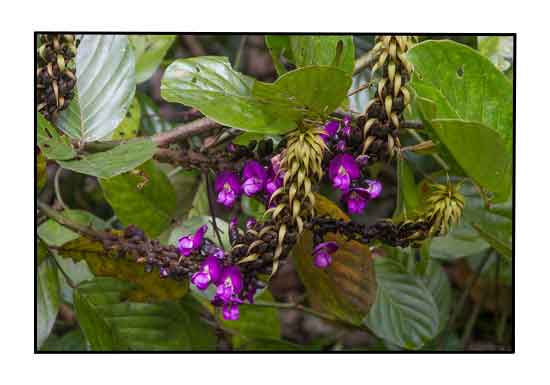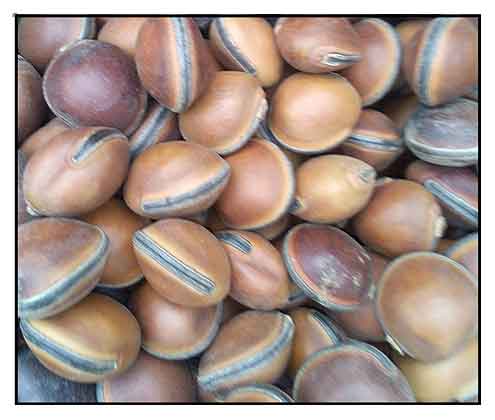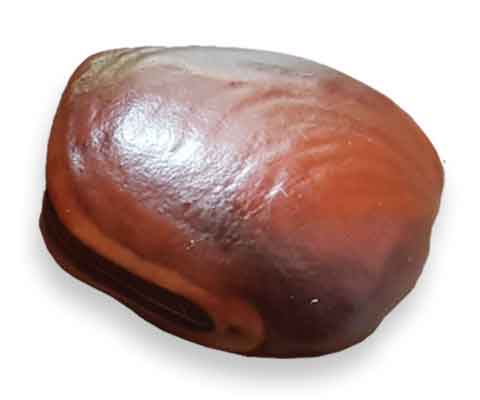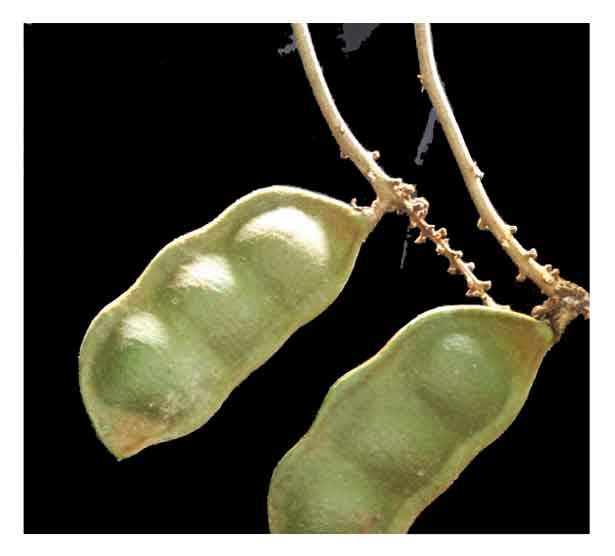 Gen info Gen info
- The Dioclea clade comprises four genera and approximately 60 species of the tribe Diocleae: Cleobulia (4 species), Cymbosema (1), Dioclea (ca. 50), Luzoni (1), and Micropsychanthus (3-4). (20)
-
Dioclea is a genus of flowering plants in the pea family, Fabaceae, which is native to the Americas. The seeds of these legumes are buoyant drift seeds, dispersed by ocean and river currents.
- Seeds can float in sea water for least 18 years (Nelson, 2000). It is a true long-distance drift-seed. (30)
Botany
Dioclea reflexa is an attractive, vigorous, climbing woody vine. Stems 4 cm in diameter, older stems up to 5 cm thick. Branches terete, at first pubescent. Leaflets subcoriaceous, acute or obtuse, hairy beneath, 10-15 cm long. Mature pods are 10-20 cm long, about 5 cm wide, and about 2 cm thick, containing 3-4 hard round, D-shaped, biconvex seeds, 25-30 mm in greatest diameter; pale, brick, brownish-red, dark brown to black, sometimes with dark speckles, with a hilum (black band around 3/4 of the seed).
Distribution
- Pantropical sea-drifted.
- Widely distributed within tropical Africa and South Africa.
- Found in coastal forests along tropical seashores worldwide.
- Seeds distributed by ocean current. Often found washed in seashores.
 Constituents Constituents
- Study of ethyl acetate soluble fraction of roots isolated two new flavonoids, dioclins A (1) and G (2) along with 3,5-dihydroxy-4-methoxybenzoic acid (3), lupeol (4) and the rare dipeptide, auratiamide acetate (5). (see study below) (4)
- Proximate analysis of D. reflexa seeds yielded ash (9.17±0.01%), crude fat
(10.65±0.01%). fiber (9.25±0.03%). moisture (13.30±0.01%), crude protein (26.00±0.43%), carbohydrate (31.63±0.12%) and calorific value (1372.07 kj/100g). Mineral analysis yielded in mg/L potassium (4.09±0.04). sodium (4.88±0.25), magnesium (0.80±0.042), zinc (2.10±0.03), iron (0.48±0.05), manganese (0.37±0.61) and calcium (7.11±0.42). Phytochemical screening of the seeds yielded alkaloids, cardiac glycosides, phlobatannin and saponin. (6)
- Leaf extract yielded alkaloids, phenols, tannins, and glycosides. (see study below)
(8)
- Study of whole seed
for proximate composition and oil characteristics yielded total ash 2.51%, moisture 7.2%, crude fiber 2.0%, crude fat 7.46%, crude protein 13.00%, carbohydrate 28.02%, and energy value of 370.02 Kcal. Fatty acid composition of seed oil yielded major constituents of linoleic acid 28.95, oleic 22.79, palmitic 12.88, stearic 7.45, behenic 4.29, and lignoceric acid 2.69, and lesser amounts of myristic, pentadecanoic, heptadecanoic, arachidic, and hexacosanoic acid. (9)
 - Hydrodistillation, GC, and GC-MS studies of D. reflexa roots for volatile oils yielded a total of 15 compounds. Hydrocarbons were the dominant group representing 69.27%. Oxygenated monoterpenoids identified included terpinen-4-ol (2.47%), myrtenal (1.69%), verbenone (1.25%), trans-pinocarveol (2.86%), and thymol (1.30%). Stearyl iodide 10.33%) was also identified. (12) - Hydrodistillation, GC, and GC-MS studies of D. reflexa roots for volatile oils yielded a total of 15 compounds. Hydrocarbons were the dominant group representing 69.27%. Oxygenated monoterpenoids identified included terpinen-4-ol (2.47%), myrtenal (1.69%), verbenone (1.25%), trans-pinocarveol (2.86%), and thymol (1.30%). Stearyl iodide 10.33%) was also identified. (12)
- Gas chromatography of seed oil for fatty acid composition showed individual unsaturated fatty acid to be oleic acid at 18:1 (0.8%), while saturated fatty acids were palmitic acid 16:0 18:0 ( 21.9%(10.2%), stearic acid 18:0 (21.9%).
(15)
- Study of ethanol soluble part of roots isolated reflevone (1), a new flavone, together with mearnsetin (2), 7,4'-dihydroxyflavone (3), and two known phytosterols, ß-sitosterol (4), and stigmasterol (5).(see study below) (18)
- Study of methanol extract of seeds yielded two steroids, namely: taraxasterol and stigmasterol. (23)
- Study of ethyl acetate soluble part of ethanolic root extract isolated three new flavonoids, reflevone (1), lexaflavanone (2) and lexaflavanol (3), together with mearnsetin (4), 7,4’-dihydroxyflavone (5), sepinol (6), pallasin (7), 4-OMGA (3, 5-dihydroxyl-4-methoxylbenzoic acid) (8), Lupeol (9), Hederagenin (10) and a rare dipeptide, auratiamide acetate (11). (see study below) (27)
- Study of nutrient composition of dehusked Dioclea reflexa seed yielded low moisture content (10.02 ± 0.27%) and high crude protein content (44.43 ± 0.45%). Ash, crude fat, crude fiber, and carbohydrate content were 3.07 ± 0.05, 1459 ± 0.36, 0.98 ±0.02, and 26.91 ± 0.18%, respectively. Mineral analysis showed it to be rich in potassium and phosphorus (496.20 ± 0.50 and 420.40 ± 0.20 mg/100g, respectively). Eighteen amino acids were detected. Three toxic substances were determined: phytic acid 318.40 ± 0.30 mg/100 g, tannin 1151.80 ± 0.20 mg/100g, and hydrocyanic acid 2.10 ± 0.05 mg/100 g. (29)
Properties
- Studies have suggested antioxidant, antidiabetic, antimicrobial, neuroprotective, nephroprotective, immunosuppressant, anticancer, hepatoprotective, nutrient, renoprotective properties.
Parts used
Leaves, seeds.
 Uses Uses
Edibility
- In Nigeria, flour prepared from the seeds used as a soup thickener. (2)
- Seeds used as emergency food in times of need.
- Cake and seed flour has appreciable amounts of protein with potential as human food.
Folkloric
- No reported folkloric medicinal use in the Philippines.
- In Nigeria, leaves of D. reflexa and Vernonia amygdalina in coconut oil applied to furuncles.
Powdered preparation of D. reflexa with other herbs, salt and potash applied for pruritus. (14) A spoonful of powdered fruit mixed with rhizome of Aframomum melegueta in palm kernel oil taken for stomach ulcer. (17) A novel medication compounded with Dioclea reflexa, Cocos nucifera, and Piper guainenses has been registered with the NAFDAC in Nigeria for the treatment of cancer presented at early stages. (19)
- Leaves traditionally used for treatment of backache.
(8)
- Decoction or poultice of leaves applied topically to treat aches and pains, skin rashes and sores. (21)
Others
- Oil: Due to high saponification and iodine levels in the oil, it has found applications in alkyl resin, shoe polish, liquid soap, and shampoo production. (15)
- Crafts: Large attractive seeds used for making jewelry. (•) Seeds used as marbles in a traditional Nigerian game. (21)
- Gum: Seed yields a gum with potential as pharmaceutical excipient. (see study below) (2)
- Insecticide: In Africa, seeds uses as insecticide and arachnicide. (21)
Studies
• Potential as Excipient / Gum from Seeds: Study reports on the extraction of D. reflexa gum (DR0gum) from seeds, which was modified by ionotropic gelation in calcium chloride solution. The basic similarities and differences in the physicochemical and functional properties of DR-gum, SXR-gum and guar gum indicated potential as pharmaceutical excipient. (2)
• Antinutritional Properties / Effect of Roasting: The presence of some antinutritional constituents such as trypsin inhibitors, phytic acid, tannins, hemagglutinins can cause adverse physiological effects and diminish the availability of nutrient, which may interfere with digestion of carbohydrates and proteins. Anti-nutritional properties can be reduced by dehulling. soaking. boiling, germination and roasting operations. Roasting can improve flavor, texture, and acceptability of products. Phytochemical constituents (phenols, flavonoids, cardiac glycosides, sterols, etc) are influenced by seed variety (light brown, dark brown, black) and roasting conditions. Optimized roasting conditions can be used to produce foods with potentials to promote better health. (3)
• Flavonoids Dioclins A and B / Antioxidants / Roots: Study of ethyl acetate soluble fraction of roots isolated two new flavonoids, dioclins A (1) and B (2) along with 3,5-dihydroxy-4-methoxybenzoic acid *3), lupeol (4) and the rare dipeptide, auratiamide acetate (5). Compounds 1 and 2 showed significant antioxidant activity in DPPH radical scavenging assay. (4)
• Antidiabetic / Mature Seeds: Study evaluated the antidiabetic effect pf seed flour of D. reflexa on alloxan-induced diabetic rats. The seed flour was found to be more effective than the standard drugs gliclazide and metformin. The oral hypoglycemic effect was probably mediated via increased peripheral utilization of glucose. (5)
• Phytoconstituents and Nutrient Potential: Study showed Dioclea reflexa seeds contain alkaloids and glycosides of pharmacological significance and high levels of carbohydrate, crude protein and moisture content with potential as supplementary source of essential nutrients for man and livestock. (6)
• Attenuation of Cognitive Impairment in Insulin-Dependent DM / Formulated Meal of Marble Vine and Plantain: Study evaluated the protective effect of formulated marbler vine/plantain dough meals on cognitive impairment in diabetic Wistar rats riven a high fat diet and a single dose of intraperitoneal STZ. Weight gain/loss, glucose and insulin levels, oxidative damage, neurological dysfunction, and histological alterations were assessed. The diet significantly ameliorated the neurological dysfunction as evidenced by increased dioamine concentration and lowered acetylcholinesterase activity, further supported by brain histopathological study. Results suggest the formulated dough has neuroprotective potentials potentials in preventing neurological complications arising from diabetes. (7)
• Antimicrobial / Leaves: Study evaluated the antimicrobial activity of crude ethanolic, methanolic, and acetonic leaf extracts from four medicinal plants against nine microorganisms viz. six bacteria, S. aureus, P. mirabilis, K. pneumonia, S. typhi, S. pneumonia, E. coli, and three fungi, A. flavus, C. albicans, and F. solani. Extracts of Dioclea reflexa showed highest broad spectrum antibacterial activity. (8)
• Dioclimidazole / Anticholinesterase / Antibacterial / Seeds: Study isolated a new secondary metabolites, dioclimidazole (1) from the chloroform extract of seeds of Dioclea reflexa. The compound was compared with huperzine A in an anticholinesterase assay. Dioclimidazole showed significant anticholinesterase activity in vitro. It also showed appreciable antibacterial activity against E. coli and B. subtilis. (10)
• Effect on Hematological and Renal Parameters After CCl4 Challenges / Seeds: Study evaluated the effect of methanol extract of D. reflexa seed on male rats following acute (single) and repeated dose (chronic) carbon tetrachloride intoxication in male albino rats. Results showed the seeds possess capacity to boost hematological parameters and protect the kidney from acute and chronic toxicological challenges. (11)
• Reflevone / Radical Scavenging / Immunosuppressant / Urease Inhibitory / Anticancer / Roots: Study of roots isolated a new flavonoid, reflorvone. The compound showed very strong immunosuppressant effect on phytohemagglutiinin (PHA) stimulated T-cell, good urease inhibitory activity compared to standard urea, and strong free radical scavenging activity. It also showed mild cytotoxic effect on human lung cancer cell line (NHI-H460). (13)
• Hepatoprotective / Antioxidant / Seed: Study showed a methanolic extract of seed following acute and chronic carbon tetrachloride intoxication in male albino rats. In both models, levels of transaminases and malondialdehyde were significantly (p<0.05) reduced in extract treated rats. There was also boosting in the levels of superoxide dismutase and catalase activities. Results suggest strong antioxidant and hepatoprotective properties in both acute and chronic hepatocellular damage and oxidative stress. (16)
• Flavonoids / Anticancer / Roots: Study of ethanol soluble part of roots isolated reflevone (1), a new flavone, together with mearnsetin (2), 7,4'-dihydroxyflavone (3), and two known phytosterols, ß-sitosterol (4), and stigmasterol (5). The crude roots extract showed significant activity against prostate cancer cell line with IC50 of 5.18 µg/mL. (18)
• Flavonoid and Phenolic Content / Antibacterial / Leaves: Phytochemical screening of leaves showed presence of terpenes only in the n-hexane extract while the methanol extract yielded flavonoids, steroids and terpenoids. Alkaloids, saponins, and anthraquinones wer3e absent in all the extracts. The methanol extract was active against K. pneumonia and P aeruginosa, and inactive against E coli, P. vulgaris, and S. aureus. Total phenolic content was 41.58 mg GE equivalent / g extract while total flavonoid was 29.82 QE / g extract. (22)
• Protein Source / Digestibility / Seeds: Study evaluated the potential of three common and under-utilized tropical leguminous seeds i.e., Dioclea reflexa, Tomentosa nilotica, and Monodora myristica as supplementary feed to ruminant livestock. The study focused on the effect of precessing methods on the nutritional composition (proximate, fiber fractions, minerals and nutrients) and in vitro digestibility of the seeds, and and suitability as feedstuff (protein sources) in small ruminant feed, especially during off-season. Dioclea reflexa showed highest organic matter digestibility, short-chain fatty acids, metabolizable energy and in vitro dry matter digestibility values. Roasting improved the nutritive value. Results suggest Dioclea reflexa can be incorporated in ruminant diet as protein source, especially for off-season. (24)
• Seed Gum Potential as Suspending Agent: Study evaluated the potential of D. reflexa seed gum as suspending agent in metronidazole suspension. Tragacanth gum (TR) was used as reference. Results showed the viscosity of DR gum was slightly higher than TR. Sedimentation rate showed no significant difference. The DR gum compared favorably with TR, indicating good properties as potential suspending agent in MTZ suspensions. (25)
• Seed Bioactives Against Breast (MCF-7) Cancers: Study reports on optimization parameters to capture plant metabolites from Dioclea reflexa seed extracts onto halloysites nanotubes (HNTs). The pH-dependent elution of metabolites showed acidic pH samples exhibited profound antiproliferative effects on cancer cells compared to basic pH metabolites. Cancer cell death could be attributed to membrane/depolarization effects. Study suggests plant metabolites could be captured using simplified screening procedures for rapid drug discovery purposes. (26)
• Bioactives Secondary Metabolites from Root: Study of ethyl acetate soluble part of ethanolic root extract isolated three new flavonoids, reflevone (1), lexaflavanone (2) and lexaflavanol (3), together with mearnsetin (4), 7,4’-dihydroxyflavone (5), sepinol (6), pallasin (7), 4-OMGA (3, 5-dihydroxyl-4-methoxylbenzoic acid) (8), Lupeol (9), Hederagenin (10) and a rare dipeptide, auratiamide acetate (11). The secondary metabolites were evaluated for immunomodulatory, urease inhibitory, lipoxygenase inhibitory and free radical scavenging activities, and invitro cytotoxicity bioassay on human non-small cell lung cancer (NCI-H460). Results suggest potential against immune disorders, gastrointestinal ulcers, and oxidative stress diseases. (27)
• Nephroprotective / Hematological Effects / Seeds: Study evaluated the effect of methanolic extract of D. reflexa seed on male rats following acute and chronic carbon tetrachloride intoxication. In the acute model, the extract significantly (p<0.05) reduced the level of total bilirubin and conjugated bilirubin compared to CCl4 control. In the chronic model, level of packed cell volume (OCV) and hemoglobin were significantly (p<0.05) boosted by extract treatment with concomitant reduction in levels of bilirubin. Results suggest D. reflexa seed possess capacity to boost hematological parameters and protect the kidney against acute and chronic toxicological challenges. (28)
• Nutrient Analysis / An Underutilized Edible Legume: Study evaluated the nutrient composition of dehusked Dioclea reflexa seed. Results suggest a cheap source of animal nutrients, which is underutilized. (see constituents above) (29)
• Vasorelaxant Lectin / Seed: Study reports on the primary and three-dimensional structure of Di9oclea reflexa seed lectin (DrfL). Similar to other Diocleinae lectins, DrfL was capable of relaxing aortic rings via NO induction, with CRD participation, albeit with low intensity (32%). Despite high similarity among Diocleinae lectins, each lectin has unique CRD properties that influence carbohydrate binding, resulting in different biological effects. (31)
Availability
Wild-crafted.
Seeds in the cybermarket.
|

![]()





 - Hydrodistillation, GC, and GC-MS studies of D. reflexa roots for volatile oils yielded a total of 15 compounds. Hydrocarbons were the dominant group representing 69.27%. Oxygenated monoterpenoids identified included terpinen-4-ol (2.47%), myrtenal (1.69%), verbenone (1.25%), trans-pinocarveol (2.86%), and thymol (1.30%). Stearyl iodide 10.33%) was also identified. (
- Hydrodistillation, GC, and GC-MS studies of D. reflexa roots for volatile oils yielded a total of 15 compounds. Hydrocarbons were the dominant group representing 69.27%. Oxygenated monoterpenoids identified included terpinen-4-ol (2.47%), myrtenal (1.69%), verbenone (1.25%), trans-pinocarveol (2.86%), and thymol (1.30%). Stearyl iodide 10.33%) was also identified. (
